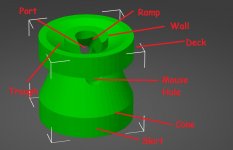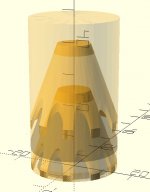It is a form of a Tesla Valve. The K baffle redirects a jet of air across the stream of air exiting the bore. That jet strikes the far wall of the moderator and splits into two streams. Both streams then make their way around the inside of the moderator back to point below the origin of the stream and thence back again into the stream of air exiting the bore. It is in fact a Tesla Valve. Well my version of it is anyway. I suppose some folks would leave off the "mouse hole", Then it is not a form of the Tesla Valve.
When I get time I'll put together a picture unless someone else wants to draw it and post it first.



When I get time I'll put together a picture unless someone else wants to draw it and post it first.
Last edited:

